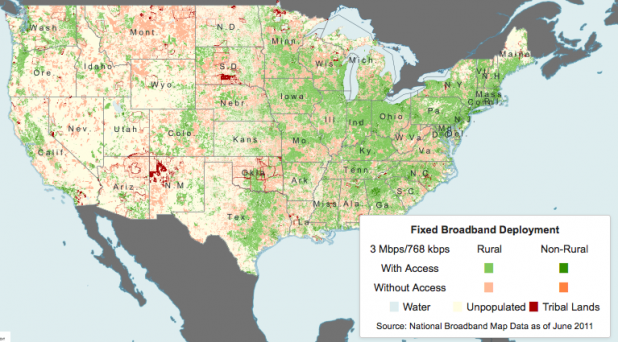
Roughly 19 million Americans lack access to broadband, according to the Federal Communications Commission’s Eighth Broadband Progress Report. Thanks to Section 706 of the Telecommunications Act of 1996, the FCC is required to give Congress an annual report on broadband penetration throughout the United States. Despite the expansion of networks technically capable of 100 megabit-and-up speeds, combined with rising LTE deployments, around 6 percent of the population lacks high-speed Internet. The situation is even worse in rural areas, where a full quarter of people lack access to broadband; in tribal areas, it’s one-third of the population without high-speed Internet. “Even in areas where broadband is available, approximately 100 million Americans still do not subscribe,” reads the FCC’s
summary of its report. “The report concludes that until the Commission’s Connect America reforms are fully implemented, these gaps are unlikely to close.” (For those keeping score at home, adding those 100 million non-subscribers to the 19 million without broadband access equals 119 million: a significant number for a country whose total population
hit 314.2 million this month.) The FCC’s Connect America Fund (CAF) aims to deliver broadband to 7 million rural Americans within the next six years, with the ultimate goal of connecting all 19 million underserved Americans by 2020. The first phase of the project involves 37 states, with the FCC claiming that some 400,000 residents and small business owners will have access to high-speed Internet within the next three years. “While 100 Mbps is impressive progress from where we were, it’s not where we want to end up,” FCC chairman Julius Genachowski
wrote in a statement. “We need to see ongoing increases in broadband speed and capacity, so that we’re routinely talking about gigabits, not megabits.” Broadband abundance, he added, “is the goal that will drive U.S. leadership in innovation, and our finding today reflects our belief that we need to keep our feet on the accelerator.” Not all the FCC’s commissioners saw the current state of broadband in a negative light. “The growth of broadband deployment in America, especially regarding the mobile marketplace, has been swift and strong,” commissioner Robert M. McDowell wrote in a
dissenting statement. “For instance, between 2003 and 2009, broadband deployment steadily increased from reaching 15 percent of Americans to 95 percent of Americans.” He also cited mobile broadband as “the fastest growing segment of the broadband market.” More broadband, of course, means more and better access to services such as streaming video. That access won’t only increase productivity and innovation; it’ll give the nation’s citizens new and amazing ways to procrastinate.
Image: FCC

